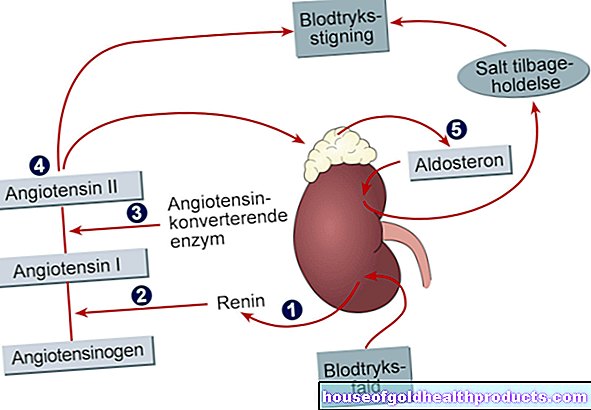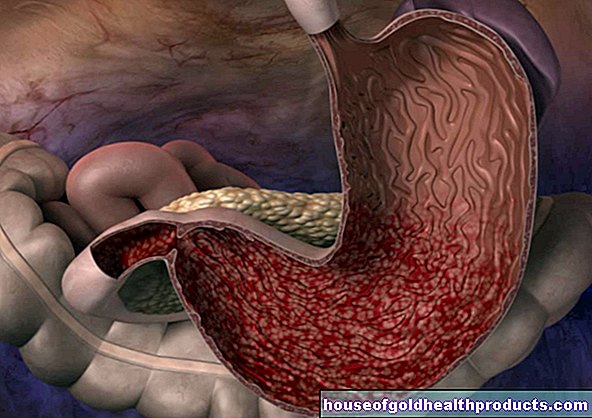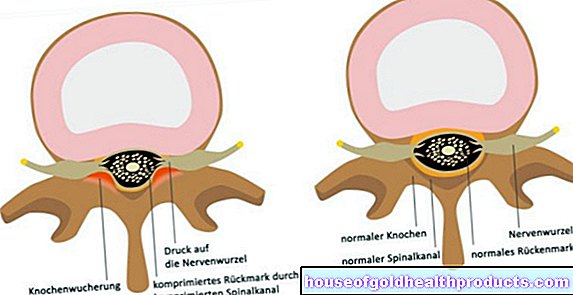Stomach reduction
Dr. med. Fabian Sinowatz is a freelancer in the medical editorial team.
More about the experts All content is checked by medical journalists.Stomach reduction is the generic term for various surgical interventions that aim to reduce weight in the case of severe overweight (obesity). The operations differ in terms of the inclusion of additional organs and the effectiveness in terms of weight loss. Find out more about the different stomach reduction methods!

Methods of bariatric surgery
Bariatric surgery (from the Greek “báros”, heaviness, weight) is a specialty of abdominal surgery. The sole aim of the operations is to reduce weight in the case of severe obesity. In all operations, the volume of the stomach is reduced. In addition to stomach reduction, further interventions in the area of the intestine are sometimes carried out.
Studies indicate that the weight reduction that can be achieved in this way not only has a cosmetic effect, but also has very beneficial effects on the entire metabolism. For this reason, bariatric surgery is now often referred to as "metabolic surgery". For example, in many diabetics, the blood sugar levels improve drastically as a result of weight loss. A positive influence on other diseases associated with obesity such as high blood pressure or increased blood lipid levels can also be demonstrated.
Surgical intervention to treat obesity is usually only considered if other treatments have failed to achieve sufficient weight reduction. As with any surgical procedure, reducing the size of the stomach involves certain risks and is irreversible. The operation should therefore be carefully considered.
The following criteria should be met for a stomach reduction:
- All non-surgical (conservative) measures such as the combination of nutritional advice, exercise training and behavioral therapy have not been sufficiently successful even after six to twelve months.
- The body mass index (BMI) is over 40kg / m² or between 35 and 40kg / m² and illnesses have already occurred due to the weight, for example diabetes, sleep apnea, high blood pressure, etc.
- The obesity has existed for at least three years.
- The patient is between 18 and 65 years old. Obesity surgery is only considered in exceptional cases for patients aged> 65 years.
- The patient is ready to maintain an active lifestyle with a varied diet even after the operation.
The following criteria speak against stomach reduction:
- The patient is known to have cancer.
- A treatable physical illness (for example, hypothyroidism) or mental disorder is responsible for obesity.
- The patient has a previously untreated eating disorder.
- An operation risk that is generally too high with an overall poor general condition.
- Some previous operations or previous damage to the gastrointestinal tract can make an operation difficult or impossible.
- They are addicted to alcohol, drugs, or medication.
Methods of stomach reduction
Bariatric surgery (obesity surgery) nowadays offers a number of different surgical methods for treating obesity. All interventions are performed under general anesthesia and can almost always be performed using the keyhole technique (laparoscopic surgery). Keyhole technology means that large abdominal cuts are no longer necessary. Instead, the instruments are usually introduced into the abdomen using three small incisions.
A small camera with an integrated light source is inserted through one of the entrances, through which the surgeon can see the operating area and the inserted instruments on a screen. The keyhole technique has the advantage that less tissue is injured and therefore healing takes place more quickly. The keyhole technique can sometimes not be used if so-called adhesions have formed in the abdominal cavity as a result of previous operations.
A basic distinction is made between so-called restrictive and malabsorptive surgical principles:
Restrictive means that the operation reduces the stomach capacity (stomach reduction) and a feeling of satiety occurs even after small portions of food. Due to the reduction in food intake achieved in this way, the weight is steadily reduced. In the case of malabsorptive procedures, on the other hand, the digestive tract is surgically modified in such a way that deliberately malabsorption (absorption disorder) of the food occurs. This is achieved by delaying the breakdown of the nutrients and thus reducing the available absorption area of the gastrointestinal tract. The maximum amount of nutrients that can be absorbed into the blood decreases as a result.
Effectiveness of surgical procedures with stomach reduction
The various techniques differ significantly in terms of their effectiveness and the severity of the operation. The effectiveness is assessed primarily with regard to the weight loss that can be achieved with it, more precisely, according to the excess weight loss achieved (EWL).
It does not refer to the total weight before the procedure, but solely to the amount above the normal weight BMI limit of 25 kg / m². So if the excess weight loss is 50 percent, this does not mean that the body weight has been halved, but that half the excess Body weight has decreased.
A calculation example: If a patient has a BMI of 45 kg / m² before the operation, this is 20 kg / m² above normal weight (= maximum 25 kg / m²). If this patient achieves a reduction in his BMI by 10 kg / m² to 35 kg / m² in the end, this corresponds to a weight loss of 50 percent of the excess weight. In contrast to the effectiveness, however, clear statements can be made about the severity of the operation. The more pronounced the normal anatomy is changed with the procedure, the more serious complications will also occur. Basically, people with obesity always have an increased risk of surgery.
The four most common surgical procedures and their effectiveness:
- Gastric band (purely restrictive method), excess weight loss of up to 50 percent
- Sleeve stomach (purely restrictive procedure) loss of excess weight of up to 60 percent
- Roux-Y gastric bypass (restrictive malabsorptive procedure) 60 to 70 percent excess weight loss
- Biliopancreatic diversion with or without duodenal switch (restrictive malabsorptive procedure), excess weight loss of up to 52 to 72 percent
In the Roux-Y gastric bypass and the biliopancreatic diversion, both active principles are combined - the stomach is made smaller and the breakdown of food is delayed. You can find more information on all four procedures on the corresponding pages.
A non-surgical procedure is the so-called gastric balloon - a mostly liquid-filled silicone balloon that partially fills the stomach. It is not brought in with an operation but as part of a gastroscopy and is therefore not part of the obesity surgery procedure in the narrower sense.
Stomach Reduction: Cost
The costs of the different stomach reduction methods vary significantly. The assumption of costs is not yet a standard benefit of the statutory health insurance (GKV). This means that statutory health insurers will only accept a stomach reduction or, in general, a bariatric operation if certain criteria are met on request. Such an application for reimbursement of costs is filled out together with a “doctor who is entitled to apply” (usually a family doctor) and must be addressed directly to the respective health insurance company. This often forwards him to the medical service of the health insurance companies (MDK), which examines the matter and either approves or rejects the assumption of costs for the stomach reduction.
Tags: elderly care interview eyes





























